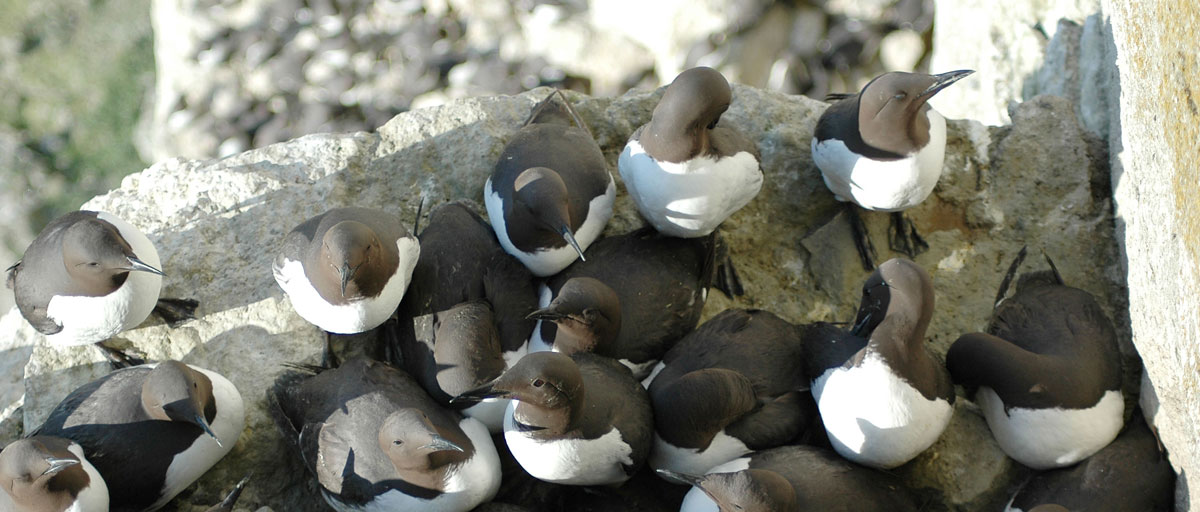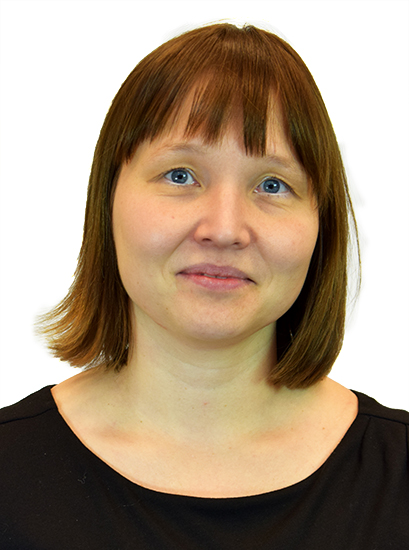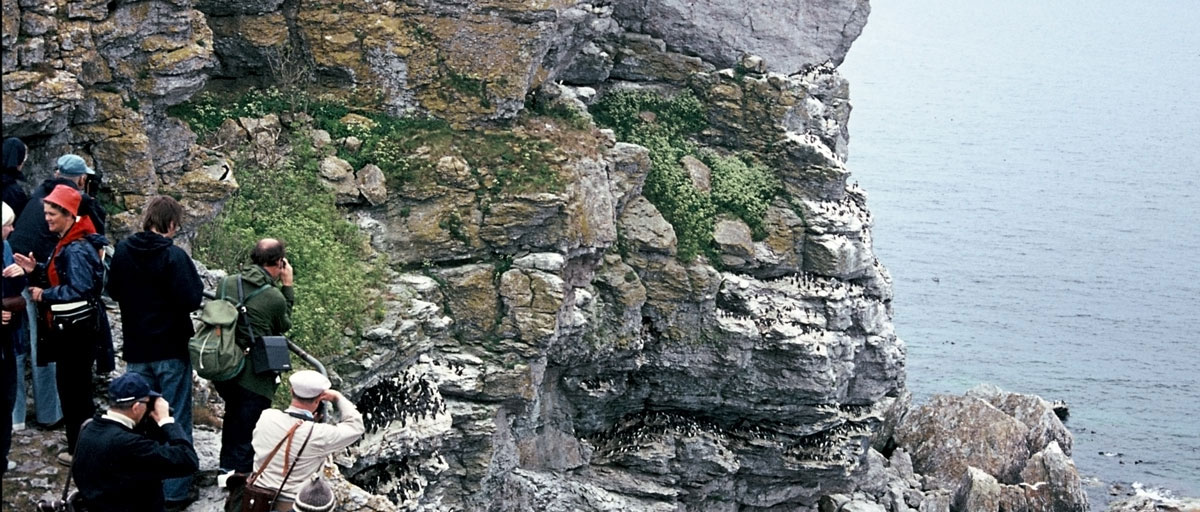
In order to evaluate different management options, ecologists often use “food-web models” that only focus on a few key species. For iconic or threatened species, another kind of “demographic” models may be used. However, few assessments combine insights from both modelling approaches. A recent study published in Ecology and Evolution does just that, looking at guillemots in the Baltic Sea. Photo: E.Kylberg/Azote
Bildtext får vara max två rader text. Hela texten ska högerjusteras om den bara ska innehålla fotobyline! Photo: B. Christensen/Azote
BIRD CONSERVATION
Don’t forget the guillemots
Proposed management interventions in the Baltic Sea can have negative side-effects on seabird conservation
- New study links survival of common guillemots in the Baltic Sea with future scenarios for management of cod fisheries and eutrophication
- Two kinds of computer models (demographic and food-web) were combined in a novel way to uncover conflicting management goals
- Simulations under six future scenarios incorporating climate change indicate positive impacts on the guillemot population, with the exception of the target ecosystem management scenario.
Discussion on management interventions in the Baltic Sea often circles around fisheries and nutrient run-off to solve the problems with algal blooms, dead zones and declining fish stocks.
In order to evaluate different management options, ecologists often use “food-web models” that focus on a few key species, while largely ignoring species occurring in lower numbers or with limited ecological function. For iconic or threatened species, another kind of “demographic” models may be used to assess management alternatives.
However, few assessments combine insights from both these kinds of modelling approaches. A recent study published in Ecology and Evolution does just that, looking at guillemots in the Baltic Sea.
“Linking the two models makes it possible to uncover important trade-offs associated with management alternatives and support conservation of less common species,” the authors write.
The study was carried out by a team from Sweden, USA and Denmark, including centre researcher Susa Niiranen. Martina Kadin who lead the study is a former PhD-student of the SRC, but now works for the University of Washington and the Swedish Museum of Natural History.
Niiranen, Kadin and their co-authors argue that the study results can be critical for decision-makers.
Our study is one of the first to link demographic models with food-web models to understand specific impacts of management actions targeting broad-scale challenges.
Martina Kadin, lead author
Six scenarios
The researchers combined modelling approach was used to analyse management of a set of key environmental factors in the Baltic Sea, including cod fisheries and eutrophication. They then projected the near (2016–2040) and distant (2060–2085) future impacts on survival of guillemots under six scenarios.
The demographic part of the model identified quantity of sprat (Sprattus sprattus) as the main factor influencing guillemot survival. Sprat is the main prey of Baltic Sea guillemots. Most simulations tested by the researchers resulted in increased survival of the birds, in the near and distant future. However, in the scenario of reduced nutrient input and precautionary cod fishing, guillemot survival was projected to be lower in both future periods due to lower sprat stocks. A substantial decline of the guillemot population was projected in the near future (24% per 10 years) and a smaller reduction (1.1% per 10 years) in the distant future.
“To date, many stakeholders and Baltic Sea governments have supported reduced nutrient input and precautionary cod fishing and implementation is underway. Negative effects on non-focal species have previously not been uncovered, but our results show that the scenario is likely to negatively impact the guillemot population,” the authors write.
Managing cod, eutrophication and guillemots
To understand why solving the problems of nutrient pollution and overfishing of cod could be negative for the guillemots you have to go back to the 1990s. During this time, sprat increased dramatically due to the collapse of the cod in the eastern Baltic. This was caused by high cod fishing pressure in combination with eutrophication effects and changes in climate, and the increase in sprat turned out to benefit guillemots.
Does this imply that we should refrain from management of cod and nutrients? No, says the authors. In fact, they come up with several strategies that could mitigate the potential negative effects on guillemots without compromising the objectives of cod recovery and reduced nutrient input. Examples include continued efforts to remove the nest predator American mink, and to reduce other sources of guillemot mortality, for example, disturbance and predation by white-tailed eagles, as well as bycatch in fishing gear.
In conclusion, the researchers say their work could help to reduce the risk of aiming for objectives that are not simultaneously achievable. They also emphasise that it is important to consider conflicting objectives both when deciding on management actions and when designing how to evaluate their success. Their new combination of modelling techniques can prove to be useful in this context, they conclude:
“Conflicting objectives will be inherent in management of any ecosystem, but integration of modelling techniques allows for better-informed decisions when aiming to balance diverse interests and drivers of change.”
Methodology
The researchers estimated annual survival probability of guillemots in a so-called demographic model using a software called E-Surge 1.8.5. This multistate demographic model allowed the researchers to account for migration to other breeding colonies, which can otherwise bias survival estimates. This model was then used to run future scenarios driven by the output from a previously published (Niiranen et al. 2013, GCB) Ecopath with Ecosim food-web to project guillemot survival under six future scenarios incorporating climate change. The scenarios were all based on different management alternatives for eutrophication and cod fisheries, issues considered top priority for management in the Baltic Sea.
Kadin, M., Frederiksen, M., Niiranen, S., Converse, S.J. 2019. Linking demographic and food‐web models to understand management trade‐offs. Ecology and Evolution https://doi.org/10.1002/ece3.5385








